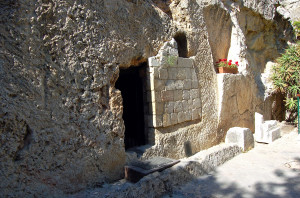At this time of year, thousands of Christians make a pilgrimage to the tomb of Jesus in Jerusalem, many having a powerful spiritual experience. Surprisingly, they have a choice of tombs and the one they pick may depend on their beliefs.
The first choice was located by Helena, who, at age 80, was sent to the Holy Land by her son, Emperor Constantine, to find sites important to Christianity. She returned in 328 A.D. with news she had found not only the tomb of Jesus in Jerusalem, but also the burning bush in the Sinai in which God appeared to Moses and the cave in Bethlehem in which Jesus was born. The Church of the Holy Sepulcher was soon built around the tomb. So, for almost 1700 years Christians have made their way to that now cavernous church. For her piety and her discoveries, Helena was recognized as a saint.
After the Reformation, Protestants began looking for another tomb, at least in part because of their discomfort in worshipping in the all-too-Catholic Church of the Holy Sepulcher. Protestants were therefore thrilled in 1883 when Charles Gordon, an English general, found a tomb near a Jerusalem rock formation suggesting a skull, which he thought identified the Biblical Golgotha where Jesus had been crucified. The tomb itself was in an old garden, where the Bible says it should be. For General Gordon, the clincher was a groove on the ground that he thought had been used to roll a stone across the opening. And so, with great fan fare the “Garden Tomb,” with its beautiful gardens and peaceful outdoor places to worship, opened to the public. Protestants came in large numbers to what they also called “Gordon’s Calvary.”
In 1986, Israeli archaeologist Gabriel Barkay, an authority on Jewish tombs, published an article concluding that the Garden Tomb was not used at the time of Jesus. He also made a simple observation that had escaped General Gordon. The groove in front of the tomb sloped away from the opening and would have prevented the tomb from being closed by a rolling stone. The groove was probably a trough for watering animals, added by the Crusaders who used the tomb as a stable.
Guides at the Garden Tomb no longer claim it held the body of Jesus. But Protestant visitors still worship there, experiencing the same emotions as before. Others continue to experience comparable emotions at the Church of the Holy Sepulcher. As with many other sites in the Holy Land, tradition and belief can be as important as archaeology. And for many, just being in Jerusalem is being close enough.

Comments are closed.